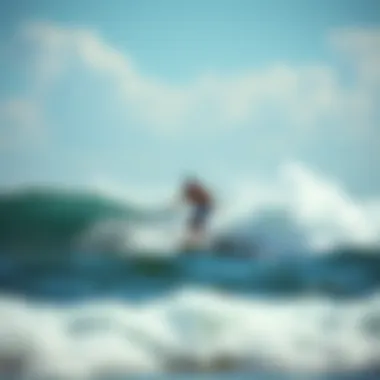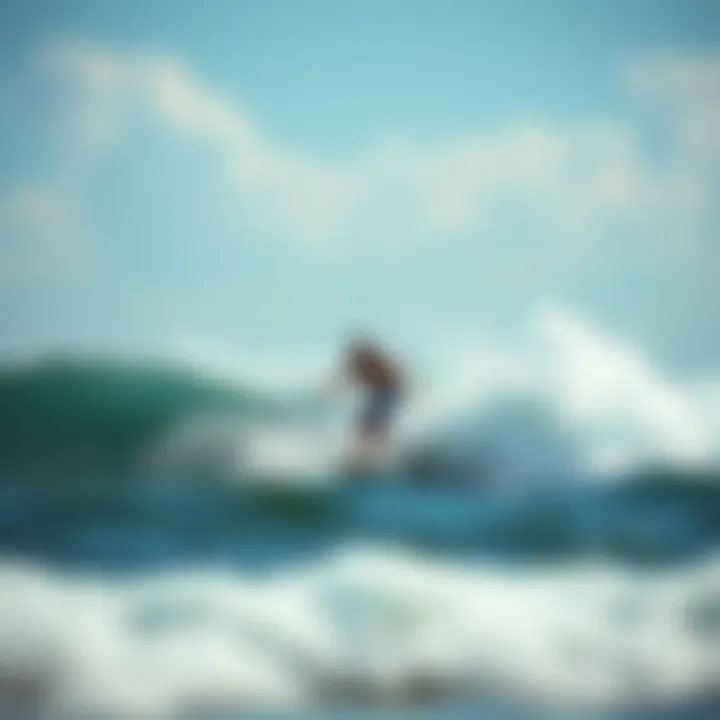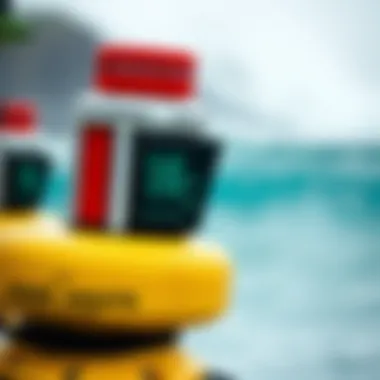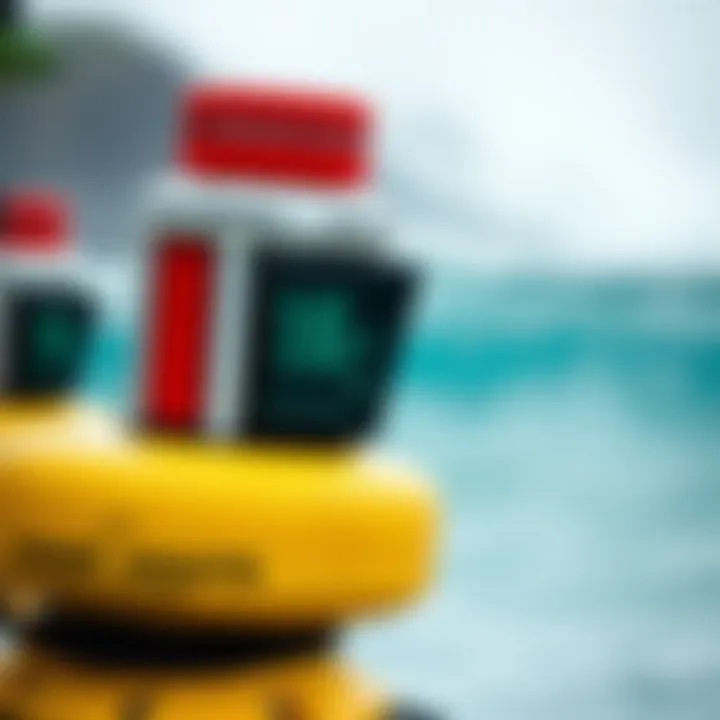Wave Predictions: Navigating Surfing Conditions with Insight


Intro
Surfing isn't just about catching waves; it's about understanding the nuances behind them. Regardless of whether you're a novice paddling out for the first time or a seasoned surfer ripping through the surf, grasping the art and science of wave predictions can enhance your enjoyment and safety in the water. You might wonder, what really influences those towering waves that beckon surfers to the ocean? This piece aims to shed light on the various elements that play a pivotal role in wave formation and how we can accurately predict surfing conditions.
From the subtleties of oceanography to the swirling complexities of meteorological phenomena, the sky and sea dance in a delicate balance that shapes every surf session. As you read on, you'll see how modern tools and technologies, such as buoy readings and satellite imagery, come into action, assisting surfers in chasing the perfect wave. With an eye on environmental consciousness, this article will also touch upon how these factors intertwine, enabling all of us to immerse ourselves in nature while being aware of our impact on it.
So grab your board, and let’s ride the waves of knowledge together!
Preamble to Wave Predictions
Wave predictions play a pivotal role in the realm of surfing. Understanding how waves form and break is not just some abstract scientific pursuit; it is a vital aspect of the surfing lifestyle. For surfers, the ability to predict wave conditions can mean the difference between scoring the ride of a lifetime or spending a day staring at flat water while stuck on the beach. In this article, we will delve into the intricacies of wave prediction—from the fundamental science that governs ocean dynamics to the technological tools that surfers and forecasters depend on.
Defining Wave Prediction
Wave prediction can be defined as the process of estimating wave properties such as height, period, and direction through various analytical methods and meteorological data. The waves we see on the surface of the water are influenced by numerous factors—wind speed, water depth, ocean currents, and atmospheric conditions. These elements create complex interactions that can make forecasting waves a Herculean task. The goal of wave prediction is not simply to provide a guess; it’s to deliver as accurate and timely forecasts as possible to help surfers make informed decisions.
To quantify wave predictions, forecasters often utilize statistical models that analyze historical data and current conditions. This mathematical modeling takes into account regional characteristics, such as local bathymetry or the shape of the coastline, which can significantly alter wave behavior.
Importance for Surfers
For surfers, wave prediction is akin to a treasure map. Knowing when and where to surf means riders can chase their passion with confidence, optimizing their chances for good waves. Some of the reasons why wave prediction is crucial for surfers include:
- Safety Considerations: High waves and turbulent conditions can pose risks. Accurate predictions help surfers avoid dangerous situations.
- Maximizing Experience: Repeatedly catching great waves can lead to an enjoyable session, heightening a surfer's experience on the water.
- Training and Competitions: Surf coaches and athletes rely on precise forecasts to plan training sessions or enter contests at optimal times.
"Good surfers don't just ride waves; they dance with them, and knowing the rhythm in advance can make all the difference."
With this knowledge, surfers become part of a larger ecosystem that respects the ocean's power while embracing its inherent unpredictability. Wave predictions not only enhance surfing but can create a sense of community as surfers often share insights and experiences based on wave conditions.
The Science Behind Waves
Understanding the science behind waves is crucial for surfers, as it sheds light on the various factors that contribute to the formation and behavior of waves. Recognizing these dynamics can help surfers choose the best times and places to catch waves, potentially enhancing their experience and skill. This section dives into the specifics of ocean dynamics and meteorological influences, laying the groundwork for effective wave prediction and surf condition analysis.
Ocean Dynamics
Wave formation
Wave formation is a critical aspect of ocean dynamics that directly impacts surfing conditions. Waves are generated primarily through wind energy transferring onto the water surface. This transfer occurs more effectively when winds blow consistently over vast areas of the ocean, creating swells that can travel long distances. The shape and height of the wave depend on several variables: wind speed, wind duration, and the distance over which it can blow, commonly referred to as fetch.
Understanding wave formation is beneficial for surfers as it allows them to gauge the power and potential of incoming waves. Since different surf breaks respond uniquely to varying types of waves, knowing how a wave forms can guide surfers to the best conditions for their skill level. However, this knowledge isn’t free of pitfalls; not every break will perform well under every condition. Understanding these nuances is key to maximizing surf success.
Tides and currents
Tides and currents represent another significant oceanic factor in wave dynamics. Tides are the regular rise and fall of sea levels caused by the gravitational pull of the moon and sun. They can create entirely different wave conditions depending on whether the tide is high or low. Some reefs and beach breaks work better on low tide, while others prefer high tide.
Currents, on the other hand, include both longshore currents and rip currents, which affect how waves behave as they approach the shore. For instance, a strong current might push waves differently than when there’s little to no current, sometimes amplifying or even dampening the size and speed of breaking waves. For surfers, staying aware of currents is essential, as it can greatly influence the surfing experience, both positively and negatively. Adjusting one's strategy based on tide and current conditions can lead to a more enjoyable surf session.
Effects of wind
The effects of wind cannot be overlooked when discussing wave dynamics. Wind direction and speed have a profound impact on wave quality and characteristics. Offshore winds, which blow from land to sea, often create cleaner and smoother waves, ideal for surfing. Conversely, onshore winds can create choppy and less desirable wave conditions.
The unique feature of wind’s influence on waves lies in its dual role as both creator and destroyer. It can conjure up magnificent swells and, at the same time, spoil them through turbulent conditions. Recognizing how to read the wind helps surfers pick the most opportune times for sessions, avoiding poor conditions and maximizing performance.
Meteorological Influences
Storm patterns
Storm patterns play a pivotal role in shaping wave activity, particularly in certain seasons when tropical storms or hurricanes occur. These weather phenomena generate enormous swells that can lead to world-class surfing conditions in certain areas. Monitoring storm activity in nearby oceans can thus be instrumental for surfers who wish to ride big waves.
Surfers often keep a close eye on storm forecasts, as these can indicate when the sea might explode with energy. However, wave sizes generated by storms vary greatly, leading to risks such as dangerously large waves or unpredictable conditions. Knowledge of approaching storms can give surfers an edge, but it also comes with a reminder of safety and caution.
Atmospheric pressure systems
The influence of atmospheric pressure systems on surf conditions is another key detail. High-pressure systems generally lead to clearer skies and calmer winds, resulting in favorable surfing conditions. In contrast, low-pressure systems can bring about chaotic weather patterns and high winds, which may hinder optimal wave conditions.
Understanding these systems helps surfers better predict when conditions will be ideal, enabling them to seize opportunities for great surfing. However, the unpredictability of weather can also catch surfers off guard, emphasizing the need for paying attention to atmospheric conditions.
Seasonal variations
Lastly, seasonal variations can significantly impact wave activity and surfing conditions throughout the year. For instance, some coasts experience consistent swells during winter months due to high-pressure weather systems that can create ideal conditions for certain surf breaks. In contrast, summer may present calmer waters with smaller waves, but it can also bring unique winds that create a different surfing experience.
Surfers who adapt their expectations and techniques with changing seasons are often rewarded with opportunities to ride different wave types. This cyclical nature of surf conditions presents continuous learning opportunities, enhancing one’s overall surfing journey.
Wave prediction is as much a science as it is an art. Recognizing and understanding the dynamics of waves can transform the surfing experience, allowing for better preparation and greater enjoyment.


Embracing the science of both ocean dynamics and meteorological influences equips surfers with knowledge to navigate the surf environment intelligently, leading to exciting and safe surfing endeavors.
Technology in Wave Forecasting
In the intricate world of surfing, understanding wave conditions boils down to one crucial element: technology. The advancements in technology not only serve to enhance the accuracy of wave forecasts, but also provide surfers with better tools to make informed decisions. In this section, we will explore various technologies that play significant roles in forecasting surf conditions, including buoy systems, satellite imagery, and wave models. Each of these technologies reveals a different side of wave dynamics, ensuring that surfers are better prepared for what lies ahead.
Buoy Systems
How buoys collect data
In the vast ocean, buoys stand as sentries, constantly monitoring wave conditions and collecting vital data. Equipped with sensors, these floating structures measure wave height, interval, period, and even water temperature. They transmit real-time information, offering a snapshot of local surf conditions. This collection of data is crucial for forecasting because it provides empirical evidence of the ocean's behavior.
Buoy systems not only track surface waves but also gather information from different depths, painting a comprehensive picture of underwater dynamics. The ability to record and analyze multiple data points makes buoys a popular choice for researchers and surfers alike, as they help understand wave patterns on a local scale. However, it's essential to acknowledge that buoys might be located further out at sea. This sometimes leads to discrepancies between real-time buoy data and conditions experienced closer to the shore.
Importance of real-time monitoring
Real-time monitoring is akin to having your finger on the pulse of the ocean. With buoy systems transmitting data as it happens, surfers can receive up-to-the-minute information on wave conditions. This immediacy can be a game saver for those who rely on accurate predictions to plan their sessions.
The key characteristic of this continuous flow of information allows surfers to adapt quickly, whether that means heading out or waiting for a better moment. Moreover, real-time data supports safety during hazardous surf conditions, informing paddle-out decisions. A unique feature of real-time monitoring is the integration of this data into apps and websites, enabling surfers to check conditions from the comfort of their homes. The drawback, however, is that technical glitches can occur, leading to temporary outages that may impact decision-making.
Satellite Imagery
Capabilities of satellite technology
Satellite imagery provides a bird’s-eye view of the ocean, capturing vast areas that are otherwise unobservable. These satellites can analyze wave heights, surface winds, and even currents from space. They offer satellite-derived data crucial for forecasting upcoming swell patterns and assessing storm systems that could impact surf conditions.
The primary benefit of satellite technology lies in its ability to cover massive areas, which proves vital during significant weather events. Surfers can utilize this information to gauge when and where a swell will arrive. Nevertheless, it is also worth noting that satellite data might lack the granularity of localized buoy data, sometimes making it challenging to predict conditions accurately.
Long-range vs. short-range forecasting
The distinction between long-range and short-range forecasting is essential for surfers navigating dynamic wave conditions. Long-range forecasts generally provide information days or even weeks in advance, helping surfers plan trips to potentially better surf locations. They can identify patterns and trends, offering insight into upcoming swell events over a larger timespan.
Conversely, short-range forecasting delivers more immediate insights, focusing on conditions expected within hours to a couple of days. This immediacy is immensely valuable for surfers looking to catch the right swell. However, while long-range forecasting allows for planning, it frequently hinges on predictive models that can sometimes fall short due to the unpredictabilities of nature.
Wave Models
Numerical models in forecasting
Numerical models act like sophisticated crystal balls in the realm of ocean forecasting. By simulating wave conditions based on various parameters, these models help predict the behavior of waves under different scenarios, considering factors like wind patterns and ocean currents. They are a cornerstone of modern forecasting practices due to their ability to process vast amounts of data and produce forecasts tailored to specific locations.
A notable characteristic of numerical models is their reliance on mathematical equations that describe wave behavior. This technical foundation allows for a high level of precision in forecasting wave characteristics. However, the effectiveness of these models is sometimes limited by the accuracy and completeness of the input data, making them one piece of a more extensive forecasting puzzle.
Limitations and assumptions
Like any predictive tool, numerical models come with inherent limitations and assumptions. They are based on specific theoretical frameworks which may not account for all the unpredictable variables at play in the ocean. For instance, assumptions about wind patterns or local geography can lead to inaccuracies in wave predictions.
It's crucial for surfers to understand these limitations, as reliance solely on numerical models might not provide a complete picture. While these forecasts can guide expectations, they should be used alongside real-time monitoring and local knowledge for the most effective decision-making when it comes to surfing. The takeaway is that a blend of technology, experience, and intuition will lead to the best outcomes in surf forecasting.
The Role of Local Knowledge
When it comes to wave predictions, local knowledge can often be the secret sauce that enhances a surfer's experience. The ocean is a living, breathing entity. Its moods shift alongside the winds and tides. Therefore, the insights gathered from those who surf in specific areas regularly can prove invaluable. It goes beyond what can be captured on radars or buoy systems; it taps into the deep roots of personal experiences and unique observations of local conditions.
Experienced Surfers' Insights
Spot checks and observations
Spot checks and observations are a hallmark of local knowledge. Surfers often take the time to physically assess conditions before hitting the waves. This hands-on approach allows them to notice details that forecasts might miss, like the subtle way water flows around a jetty or how crowds react to changes in swells. The beauty of these observations lies in their immediacy—surfing conditions can turn on a dime, and what seemed like ideal conditions might shift within seconds.
This phenomenon makes spot checks a popular choice among seasoned surfers. They can almost predict the feel of the waves just by standing at the shoreline, something that numeric data can’t replicate. The key characteristic of this practice is its real-time nature, enabling surfers to adjust their plans and strategies accordingly. However, this method can be subjective and clouded by personal biases or lack of experience, which is worth considering.
Understanding local conditions
Understanding local conditions is another vital element that seasoned surfers emphasize. Each surf spot has its own personality, shaped by a multitude of factors including seabed composition, local winds, and even seasonal wildlife migrations. Knowledge of these factors contributes significantly to one’s ability to predict what the waves may deliver. For instance, a reef break can differ drastically from a beach break, and understanding how tides affect each can make a world of difference in a surfer's ride.
One unique feature of grasping local conditions is that it often engenders a sense of community amongst surfers. Recent trends show that surfers are more likely to share tips about local spots and their nuances, enriching the surf culture further. The advantage here is mutual benefit; as seasoned surfers impart wisdom to novices, everyone stands to gain from an enhanced understanding of each spot. On the flip side, local conditions can be challenging to fully articulate or communicate to others, creating a gap between experienced surfers and newcomers.
Community Contributions
The surf community plays an integral role in nurturing and sharing local knowledge that can aid in wave predictions. This collaboration fosters a unique atmosphere where insights flow freely.
Shared experiences
Shared experiences refer to the collective knowledge gathered from various surfers who ride the same waves. This pool of insights emphasizes not just conditions but also the feelings associated with surfing; the thrill of catching a great wave or the frustrations of a flat day can all weave together to create a richer narrative of a surfing spot.


This characteristic of shared experiences is particularly beneficial because it gives newer surfers a glimpse into what to expect—far beyond the stats. Personal stories are powerful tools that inform and inspire others; they can even foster emotional attachments to specific surf spots, making surfers feel more connected to their underwater playgrounds. However, anecdotal experiences can sometimes be misleading if the group involved lacks varying perspectives or if they skew towards extreme cases.
Local surf reports
Local surf reports are often regarded as a lifeline for surfers seeking reliable information before heading out. These reports can vary from brief updates shared on social media platforms like Facebook, Reddit, or even through dedicated websites. They provide an important snapshot of what to expect at local beaches, including size of the waves, tide times, and weather conditions.
Their key characteristic is timeliness; most reports are updated frequently to reflect the ever-changing nature of wave conditions. This immediacy makes local surf reports a cornerstone of how surfers plan their days. While there are numerous apps and tools available for wave forecasting, community-driven local reports bring a human touch that can’t be replicated by technology. On the downside, these reports are reliant on those contributing for their accuracy and may not always provide insights into less popular surf spots.
Environmental Considerations
When we dive into wave predictions, we can't turn a blind eye to environmental considerations. They play a crucial role in shaping the conditions surfers rely on. Understanding these elements not only enriches the surfing experience but also fosters a deeper respect for the aquatic world we share with nature. The dialogue around environmental awareness in surfing is growing, and for good reason; it highlights the need for sustainability, not just for surfers but for future generations.
Impact of Climate Change
Shifts in wave patterns
Climate change is making waves in every sense of the phrase. One significant aspect is shifts in wave patterns that affect surf conditions globally. As the climate warms, the rise in ocean temperatures leads to changes in wind patterns, which in turn alters wave formation. This is no trivial matter. Surfers often find themselves facing conditions that are markedly different from what they have come to expect from coastal breaks over the years.
One key characteristic of these shifts is the variability in wave height and frequency. Some areas may experience increased wave energy, while others could face diminished surf quality. For surfers, this unpredictability can be both exciting and frustrating. On one hand, it might present unique opportunities for exploration and discovery; on the other hand, consistent access to quality surf may become increasingly sporadic.
Unique to this point is how these patterns can create an advantage for some surfers and a disadvantage for others. Those who are flexible and willing to adapt to new conditions may find themselves thriving, while traditionalists may struggle to manage the evolving scenarios.
Long-term forecasting challenges
Long-term forecasting faces a real uphill battle with the shifting tides of climate change. As we venture into the unknown, predicting future wave patterns becomes trickier than ever. One noteworthy characteristic is the lack of historical precedent. Previous data is becoming less relevant due to rapid environmental changes, leaving forecasters scrambling.
The unique nature of long-term predictions lies in their reliance on evolving climate models. These models must continuously be updated to reflect new data streams from our changing oceans. The advantages here include a better understanding of potential future surfing conditions. However, the downside is evident: forecasts may become less reliable, leaving surfers with a gamble on their hands when planning trips.
Conservation Efforts
Protecting marine ecosystems
Protecting marine ecosystems is paramount in the discussion of wave predictions. Healthy ocean environments contribute to stable wave patterns and ultimately affect the surf experience. One vital aspect here is the biodiversity that supports the ocean's natural balance. Coral reefs, mangroves, and seagrasses play a role in wave formation by buffering wave energy and providing habitats.
The key characteristic of focused conservation efforts is their potential to mitigate the adverse effects of climate change. By promoting sustainable practices, we create resiliency in marine ecosystems. This, in turn, leads to more favorable conditions for surfers. The catch? These efforts require consistent support and advocacy from both surfers and the broader community.
A unique feature of protecting marine ecosystems is the intersection of surfing and activism. Surfers are often some of the most passionate advocates for ocean health, using their platforms to raise awareness. This synergy can yield significant advantages, as engaged and informed communities often find more success in ensuring lasting changes.
Sustainable surfing initiatives
Sustainable surfing initiatives are cropping up across the globe as surfers seek to align their passion with responsible practices. A notable aspect of these initiatives is their emphasis on minimizing environmental footprints. From eco-friendly surfboard materials to beach clean-up events, the movement aims to create a culture where sustainability is woven into the fabric of surfing.
The key characteristic here is the growing awareness among surfers. As people become more conscious of their impact, they are seeking out brands and practices that reflect their values. This shift presents a beneficial opportunity for enhancing the surfing culture as a whole: responsible surfing can only lead to more enduring environments and better surf conditions.
Unique to this narrative is how these efforts can often lead to camaraderie within the surf community. Engaging in sustainable initiatives fosters connections between experienced surfers and newcomers alike, resulting in a collective power to push for more significant changes in policy and practice. However, there are challenges, such as ensuring access to sustainable options and combating the resistance to change that might exist in traditional surfing communities.
Embracing environmental considerations within wave predictions not only enriches the surfing experience but also ensures the preservation of the environments that our sport relies on. Surfers hold a unique position as stewards of the ocean, and with that privilege comes responsibility.
Connecting Surf Culture and Science
The Surfer's Ethos
Respect for natural elements
Respecting natural elements is essential in surfing as it fosters a bond between the surfer and the ocean. Surfers often feel that their experience is incomplete without acknowledging the power and beauty of the sea. This respect shapes their behavior, guiding them to proect marine ecosystems and understand the local environment.
A characteristic aspect of this ethos is the belief in sustainable practices. Surfers are increasingly advocating for conservation efforts, putting pressure on policy makers to implement guidelines that protect coastal areas. This not only benefits marine life but also enhances surfing experiences, ensuring waves remain consistent and healthy.
An advantage of respecting natural elements is the sense of community it builds among surfers. When they prioritize the environment, they feel united in their purpose, creating strong ties. This shared ethos also encourages newcomers to embrace responsible practices early on, promoting long-term benefits for the sport and the environment. However, it does have disadvantages, as some may view environmental efforts as barriers to surfing access, leading to friction within the community.
Influence of culture on practices
Cultural influence plays a vital role in shaping surfing practices, impacting everything from style to conservation efforts. Many surfers come from a long tradition, and passing down knowledge through generations is fundamental. This reinforces a collective identity that defines various surf cultures worldwide, such as the Polynesian connection or the Californian surf scene.
One key characteristic of this influence is how local traditions inspire surfing techniques and etiquette. For instance, in regions with rich histories, surfers often adapt their approach to the waves in alignment with indigenous practices. By integrating local customs, surfers develop a stronger respect for their environments and foster a sense of belonging.
As unique features of this cultural landscape, many surfers actively participate in beach clean-ups or advocacy events linked to their heritage. This practice not only helps the environment but also raises awareness and strengthens community ties. However, a disadvantage is that some surfers might hold onto outdated practices, resisting innovative techniques that could enhance the sport's evolution.
Sharing Knowledge in the Community
Workshops and discussion forums
Workshops and discussion forums are gaining prominence as a way to spread knowledge among surfers. These gatherings promote understanding of wave conditions, environmental issues, and wave forecasting techniques. It also encourages interaction where experienced surfers can impart crucial tips and insights to newcomers.


A main characteristic of these workshops is their hands-on approach. Participants often get to engage in discussions that are practical and relevant, creating an appealing learning atmosphere. This choice is useful for enhancing the collective skill level of the surf community, ultimately benefiting everyone.
Moreover, they enable community members to solve shared problems. As surfers address local concerns such as pollution or access issues, they can brainstorm solutions together. However, there's a downside; organizing such events can sometimes lead to divided opinions if the talks sway towards contentious issues.
Online learning platforms
Online learning platforms have revolutionized how surfers access information about wave predictions and surfing techniques. With instructional videos, articles, and real-time data, surfers around the globe can learn about their sport at their own pace.
What's beneficial about these platforms is their accessibility. Virtually anyone with an internet connection can tap into a wealth of intel. This democratization of knowledge cultivates a more informed community, as it helps surfers from different backgrounds enhance their skills and environmental awareness.
A unique feature of online platforms is offering tailored content based on local wave conditions. As surfers input their location, they unlock specific resources related to areas they surf. However, a downside might be the vast amount of information available. Surfers could easily get overwhelmed or misled by unreliable sources if they don’t verify the info they come across.
Challenges in Wave Predictions
Predicting wave conditions is vital for surfers—understanding the challenges that come with this task can make all the difference between a day riding the perfect wave or one spent clambering over unyielding and dangerous conditions. The ocean is a complex entity; it behaves unpredictably due to numerous factors that can affect surfing conditions. This unpredictability not only impacts surfers but also the development of forecasting methods, keeping the dynamics of the sport intriguing.
The Complexity of Ocean Behavior
The unpredictability of the ocean's actions is a prime factor in understanding wave conditions. Waves are born from complex interactions in nature, making it essential to explore these elements closely.
Variables in play
The ocean serves as a complicated matrix where different forces exist at once. Waves form through a combination of wind speed, duration, and fetch—the distance over which the wind blows. This interplay of factors shapes wave quality and size significantly. Moreover, environmental elements like local topography, bottom contours, and ocean currents can drastically alter the conditions.
This complexity makes it crucial in our understanding of wave formation, allowing surfers to gauge the breakpoints and ideal riding conditions. However, it also brings a degree of risk. While some variables can be monitored efficiently, others fluctuate without warning. Therefore, a thorough understanding is not just beneficial; it’s paramount for safety.
"Understanding local conditions can turn an average day at the beach into a surf paradise."
Unpredictability of nature
Nature is, by its very essence, unpredictable. With shifting weather patterns and fluctuating ocean conditions, even the most advanced forecasts can miss the mark. Unforeseen weather changes such as squalls or sudden warm fronts can produce drastic alterations in wave behavior. This uncertainty is a constant headache for surfers and forecasters alike. Nevertheless, embracing this unpredictability can bring about a certain thrill for surfers. It’s part of the game—riding the tide of not just waves but also the ever-changing nature around them. What was a small swell one minute could turn into a crisp, exhilarating ride the next. Understanding this unpredictability helps surfers adjust their mental approach, sharpening their instincts.
Technological Limitations
While science and technology have helped surf forecasting improve, limitations remain that can affect accuracy.
Data inaccuracies
Data gathering is foundational to predicting wave conditions. However, the primary challenge lies in inconsistencies that arise from faulty instruments or errors in data processing. These inaccuracies can stem from various sources, such as environmental noise or sensor malfunctions, leading to misguided expectations for surf conditions. For a surfer, this could translate into lost opportunities or risky situations when hitting the water, as the reliability of data directly influences decision-making. Tracking these inaccuracies remains a challenge, which fuels ongoing improvements in technology to create more dependable systems.
Modeling errors
Wave forecasting relies on complex mathematical models to simulate conditions based on various parameters. However, these models often have limitations that can skew results. Simplifications are sometimes necessary in modeling, which can leave out significant local influences that affect wave behavior. Consequently, even the best models can deliver inaccurate forecasts, leaving surfers at a loss. This issue, while it challenges current forecasting capabilities, also opens the door for innovation. As technology advances, more sophisticated models continue to emerge, promising closer approximations of the chaotic nature of waves.
Understanding these challenges allows surfers to improve their skills and decision-making while also ensuring they stay safe in the water.
Future Developments in Wave Forecasting
The landscape of wave forecasting is on the brink of a remarkable transformation. As surfers eagerly seek the ultimate wave, advancements in predictive technologies are paving the way for more precise and timely information. The synergy between surface data and sophisticated processing methods is beginning to yield significant results. In this section, we will explore how technology is evolving to enhance wave predictions in diverse environments.
Advancements in Technology
Machine learning applications
Machine learning is carving out a vital role in wave forecasting. By utilizing algorithms that learn and adjust based on massive datasets, these tools can analyze historical weather patterns, wave data, and ocean behavior. What's noteworthy here is the adaptive nature of machine learning — it doesn't merely crunch numbers but evolves with input data. This creates a highly responsive system capable of yielding enhanced accuracy in predictions.
For surfers, this means that forecasts will become more reliable, providing them with critical information about wave conditions ahead of time. One unique feature of these machine learning models is their ability to handle real-time data streams. This adaptability allows for swift recalibrations in forecasts if unexpected conditions arise, offering a competitive edge for surf enthusiasts. However, challenges do exist, including the requirement of vast amounts of quality data for training purposes, which can limit accessibility for some areas.
Improved satellite capabilities
The advent of improved satellite technology plays a crucial role in current wave forecasting practices. These advanced satellites offer unprecedented coverage of oceanic regions, enabling forecasters to observe and analyze wave heights, wind speeds, and atmospheric conditions with remarkable precision. The ability to capture vast amounts of data over both short and long ranges means that surfers can now be armed with better insights than ever before.
One compelling aspect of modern satellites is their capability to provide near-real-time imaging. This access can lead to significant advantages in predicting both local and remote surfing conditions. However, it is worth noting that reliance on satellite data might introduce inconsistencies, particularly in areas where cloud cover obstructs visibility. This is an important consideration for forecasters and surfers alike as they navigate the balance between satellite insights and local knowledge.
Integrative Approaches
Combining data sources
The integration of multiple data sources is emerging as a cornerstone in enhancing wave forecasting accuracy. By pulling together information from buoy reports, satellite imagery, and local weather stations, forecasters can create a more comprehensive picture of conditions along the coast. The key characteristic of this approach is its ability to harness diverse data streams for more precise analyses. For surfers, this means accessing a more holistic understanding of wave conditions, tailored to specific coastal environments.
A notable feature of this integration lies in its potential to identify discrepancies between various data sources, allowing for a clearer understanding of prevailing conditions. While this approach can elevate the quality of forecasts, it does come with added complexity, as analysts must ensure consistency and reliability among the various data types.
Predictive analytics
Lastly, predictive analytics is taking wave forecasting to the next level by utilizing sophisticated statistical techniques to forecast future wave conditions. This approach not only looks at current data but also factors in historical trends to anticipate changes. The key feature here is the foresight that predictive analytics can offer, which is crucial for surfers planning their outings.
Through this method, forecasters can generate a clearer picture of potential wave dynamics days ahead of beachgoers. While it provides substantial value, one drawback to be aware of is that predictive understandings might not account for sudden environmental shifts, which can happen in the ocean. Surf enthusiasts will need to keep that in mind as they plan their sessions and monitor updated forecasts.
"Employing integrative approaches can pave the path to a significantly enhanced predictive framework, ultimately providing surfers the information they need to make informed decisions."
The journey of wave forecasting is one of continuous evolution, influenced heavily by advancements in technology and the creative application of data. As surfers, instructors, and enthusiasts, embracing these developments will only enrich our experiences on the water.



